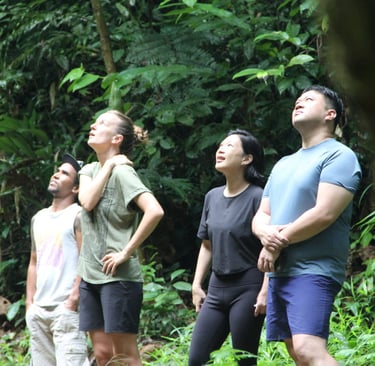10 Things About Sumatra You May Never Get Used To
Sumatra, the sixth-largest island in the world, is a quintessential example of the extraordinary diversity of ecosystems that can coexist within a relatively small geographical area. This Indonesian island is renowned for its lush rainforests, which harbor a vast array of plant and animal species, some of which are found nowhere else on Earth. The varying climates, altitudes, and geographical features all contribute to this rich biodiversity, making Sumatra a hotspot for ecological research and tourism.
8/18/20254 min read


The Profound Diversity of Ecosystems
The island's rainforests are home to unique flora such as the giant Rafflesia arnoldii, which boasts the largest single flower in the world, with a diameter of up to three feet. Furthermore, Sumatra's dense jungles are among the last strongholds of critically endangered species like the Sumatran orangutan, Sumatran tiger, and the Sumatran elephant. These animals, along with a myriad of other endemic species, play a vital role in the ecological balance and provide invaluable opportunities for wildlife tourism.
In addition to the rainforest ecosystems, Sumatra features stunning coastal areas that offer a different range of biodiversity. The coral reefs surrounding the island are teeming with life, including colorful fish and various marine mammals, which contribute to both tourism and the local economy. The juxtaposition of the pristine beaches and the dense jungles offers tourists a unique experience that is hard to replicate elsewhere.
The existence of such diverse ecosystems significantly impacts local culture and tourism in Sumatra. Many indigenous communities have deep-rooted connections to the land and its resources, which shape their traditions and way of life. The island's natural wonders serve as a draw for eco-tourists, leading to efforts aimed at conservation and sustainable practices that benefit both the environment and the local populace.
The Overwhelming Natural Beauty
Sumatra, one of Indonesia's largest islands, is renowned for its breathtaking natural beauty that leaves a lasting impression on all who visit. The island boasts an array of landscapes, from majestic mountains to serene lakes, each offering a glimpse into nature's artistry. Among the most remarkable features is Lake Toba, the largest volcanic lake in the world, which is nestled within the caldera of a supervolcano. With its crystal-clear waters and surrounding lush greenery, Lake Toba serves as a stunning tableau that often invokes feelings of tranquility and reverence in visitors.
Equally captivating is Mount Sinabung, an active volcano that stands as a testament to the earth's raw power. Its imposing presence is accompanied by a backdrop of verdant hills and agricultural land, where local farmers cultivate rice and other crops. The sight of the towering peak, especially when shrouded in clouds or smoke, provides an exhilarating contrast to the peaceful surroundings, reminding travelers of the island's volatile geological character. For many, this dichotomy can be overwhelming, showcasing the beauty and danger imbued in nature.
The Bukit Barisan mountain range, which stretches for nearly 1,500 kilometers along the western coast of Sumatra, further enhances the island's dramatic scenery. The rich biodiversity found here, including dense rainforests and stunning waterfalls, appeals to nature enthusiasts and adventurers alike. Hiking through these mountains can be both an exhilarating and humbling experience, as the sheer scale and magnificence of the landscapes challenge the perceptions of those unaccustomed to such grandeur.
The overwhelming natural beauty of Sumatra is not merely a visual feast; it also serves as a reminder of humanity’s smallness in the face of nature's vastness. This realization can inspire reflection and foster a deeper appreciation for the environment, creating an unforgettable experience for visitors.
The Unique Local Cuisine
Sumatra is renowned for its vibrant and diverse culinary landscape, showcasing a range of unique flavors that often leave an indelible mark on the palates of both locals and visitors. The cuisine is characterized by its intense spiciness, with sambal—a condiment made from chili peppers—being a staple on almost every dining table. This fiery accompaniment is just one of the many elements that define the culinary traditions of Sumatra, where meals are often prepared with a variety of indigenous ingredients such as rice, fish, and tropical fruits.
One cannot discuss Sumatran cuisine without mentioning its distinctive dishes, such as Rendang, a richly spiced meat dish that exemplifies the use of slow-cooking techniques to create deep flavors. Additionally, the coastal regions feature an abundance of seafood, delivering fresh catches prepared in ways that highlight their natural tastes while introducing bold spices. The use of local herbs, such as lemongrass and turmeric, further amplifies these flavors, resulting in dishes that are both aromatic and invigorating.
For those unfamiliar with this gastronomic culture, adapting to these unique culinary practices may be a surprising endeavor. The emphasis on communal dining may present a shift from more solitary eating habits; meals are often enjoyed family-style, where shared dishes foster a sense of community and togetherness. Additionally, the balance of textures and flavors is crucial in Sumatran meals, requiring an open mind to appreciate the interplay of spicy, salty, sweet, and sour elements.
The indigenous food culture reflects the regions' rich history and traditions, and it's commonplace to see traditional ceremonies surrounding meals. These rituals not only emphasize the importance of food but also highlight social bonds and cultural identity, making the dining experience in Sumatra both unique and enlightening for newcomers.
The Cultural Melting Pot
Sumatra, the sixth-largest island in the world, is renowned for its rich tapestry of cultures and ethnicities. The inhabitants represent a multitude of ethnic groups including the Batak, Minangkabau, and Acehnese peoples, each contributing unique traditions, languages, and social norms to the island’s cultural landscape. This cultural diversity not only enriches the experience of travelers but also poses unique challenges, particularly for those unfamiliar with the local customs and traditions.
The Batak people, who primarily inhabit northern Sumatra, are known for their distinct customs, traditional clothing, and vibrant music. Their practices revolve around communal life and strong familial ties, which can feel both welcoming and foreign to visitors. On the other hand, the Minangkabau people, who predominantly reside in West Sumatra, boast the world's largest matrilineal society. This cultural aspect can be surprising for many as women hold key roles in familial organization and property inheritance, contrasting drastically with patriarchal norms prevalent in many parts of the world.
Equally significant are the Acehnese, known for their adherence to Islamic practices and customs. Visitors may encounter norms around dress and social interactions that differ considerably from those in Western societies. Language barriers can further complicate communication, as many ethnic groups within Sumatra speak their dialects; Bahasa Indonesia serves as the national language but may not be widely spoken in rural areas.
Travelers immersed in this cultural melting pot may experience enriching encounters but are also urged to approach these differences with sensitivity and respect. Understanding the various rituals, celebrations, and social etiquettes can greatly enhance one’s travel experience, making it not only enjoyable but also educational. Embracing the diverse cultures of Sumatra leads to a broader perspective and a deeper appreciation for this fascinating island.
Contact Info
Email: book@sumatratrekkingorangutan.com
WhatsApp: +62821 - 3474 - 0414
© 2025 I Sumatra Orangutan Trekking.


